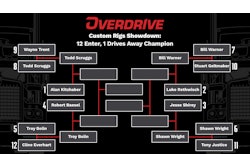Rusty Wallace unveils the car he will drive in 2005, his final season in the NASCAR NEXTEL Cup Series.
Final Run for the Cup
Wallace plans to leave racing while he’s still at his best
I’ve always liked Rusty Wallace. He’s a guy who can cuss like a sailor, but who rarely does it to be vulgar. He can speak his mind, but he doesn’t come across like a jerk.
He’s a throwback to the down-home days of NASCAR, yet he fits right in with the more media-savvy drivers of today.
But he’s also smart enough to know when it’s time to walk away, and that makes me like him even more. Wallace recently announced the 2005 season would be his last and would end with “Rusty’s Last Call.”
Normally I cringe during so-called farewell tours. By the time Richard Petty hung it up, his driving skills were long since gone. Same is true for Darrell Waltrip, who hung around at least three years too many.
As for Wallace, he hasn’t been a legitimate threat for the points crown since 1995, when he finished fifth. But he’s remained competitive, so maybe this 36-race goodbye won’t be so bad.
That Rusty’s Last Call – a good name for a farewell tour bidding adieu to a driver sponsored by the Miller Brewing Company – will take place next year just seems right. He already has a victory this year, and who knows? Maybe there are a couple more left in him.

Thing is, when he leaves the sport he won’t be exiting as the shell of the driver he once was. He’ll leave as a seasoned warrior who decided to leave the war behind.
“I still feel like a champion, but I don’t want to get hurt,” says Wallace, who cited good friend Dale Earnhardt’s death at Daytona in 2001 as one of the reasons he was giving up competitive driving. “I want to hang around this sport more. I know it’s the right time, and I know I’m doing the right thing, and I feel good about it.”
He should. I mean, the guy has nothing left to prove. As a Late Model racer in the mid-1970s he won more than 200 features. In 1979 he hooked up with USAC and claimed Rookie of the Year honors. He also won an ASA title in 1983.
In fact, it was that series where he actually won a race at Talladega Superspeedway, a track that has been a thorn in his side for his entire Winston Cup career.
Speaking of NASCAR, Wallace made his debut in what was then known as Winston Cup racing in 1980, and the Missouri native ended up doing pretty good for himself over the next quarter of a century.
He won Rookie of the Year accolades in 1984 (his first full season in the big leagues), and his first win came at Bristol Motor Speedway on April 6, 1986.
He claimed the series title in 1999 and now has 55 checkers, which ties him with Lee Petty for eighth on the all-time list. There’s no question that as soon as he becomes eligible for induction into the International Motorsports Hall of Fame, he’ll make it, just as there’s no question that years from now – when today’s young guns have become old-timers – the name Rusty Wallace will still be synonymous with good, hard racing.
That being said, he could race another 15 years and his legacy wouldn’t be tainted. But to me it’s still nice to see someone know their limitations – know that it’s time to walk away instead of being carted away.
So here’s hoping Rusty’s Last Call will prove to be a glorious curtain call for one of the sport’s good guys.
“This is my last shot at the Daytona 500,” Wallace says of next year’s season opener. “The Daytona 500 is still the granddaddy of them all. It’s the race I haven’t won, and I’m going to try my darndest to win it.”
Chances are Wallace’s winless streak in the stock car “Super Bowl” won’t end next February, but that’s OK. He hardly needs another victory to validate a terrific career.
The bottom line is that Wallace will be missed, but he’ll also be remembered as a champion who accomplished more than most and left on his own terms.
How nice it would be if we could all end our careers in that same fashion.
Draggin’ with Buddy
Baker still a magician at drafting techniques
Here’s a guy who knows how to draft, and how to do it at very high speeds.
Buddy Baker no longer competes in NASCAR Winston Cup racing. He spends most of his time at the track in television booths these days – and testing cars for Penske Motorsports as well as running the Buck Baker Driving School – but he remains a master of the drafting technique.
In late 1997, Baker lent his expertise to Jeremy Mayfield, offering to help the young driver bone up his superspeedway program. Baker was glad to help.
“When I work on these superspeedway projects, it keeps me up on what the race cars feel like,” Baker says. “I feel like I can contribute to what makes the cars run fast at Talladega and Daytona because they were both my best tracks.
“Restrictor plate racing is like grown-up chess,” Baker says. “You have to make the right moves at the right times and stay with the company you’re comfortable with.”
If a driver can’t draft at Talladega or Daytona, he can’t win on NASCAR’s fastest tracks.
“It’s like the old saying about how you have to play the game with people at least as good or better than you to stay in the game. I think the biggest thing is getting with the right people. Get comfortable, get both feet on the floor, then go after them.”
While superspeedways were his forté, Baker was a 19-time winner on the Winston Cup circuit and competitive everywhere he raced.
“I do a lot of work with [Buck Baker Driving School], and the biggest thing about racing as long as I did was that I learned a lot,” he says. “Sometimes you notice even the greatest golfers will go up to a club pro and ask them to watch their swing and try to figure out what they’re doing wrong.
“Sometimes just the verbal part that you can add to a certain place on the race track is important.”
One factor all drivers must come to grips with in NASCAR racing is “the draft.” No one knows how it works and why it works better than Baker.
“This is the best way I can explain it,” Baker says. “You’ve run across a paper bag on the interstate, and you look back and the bag is actually coming towards the car.” That’s because a racecar cuts a big hole in the air with the front end of the car, and then the air going down the side splits.
“It starts to turbulate as it goes down over the sides and over the top. When it gets to the back of the car, it actually comes forward toward the car, and that’s what you call drag.”
Baker continues, “When a car gets behind you in this turbulence it’s actually pulling them towards the car, and the sides of the racecar has the same kind of turbulence. It actually pulls the car forward as you get up beside one.
“You have to know how to use it, but it’s such an effective tool when you really get after a guy to use the draft. The draft itself will keep you where you belong.”
Mayfield, for one, has learned well from the master and now has a handle on the art of the draft.
“The air is either your friend or your enemy at Talladega,” Mayfield says. “Every bit of work you do on the car is to try to get through the air a little better. Once you get into the draft, the way the air moves around determines how stable your car is – or how unstable it is.
“If it moves the right way, the air is your best friend in the world. If it swirls the wrong way, all you can do is hold on and hope everything works out the way you want.”








